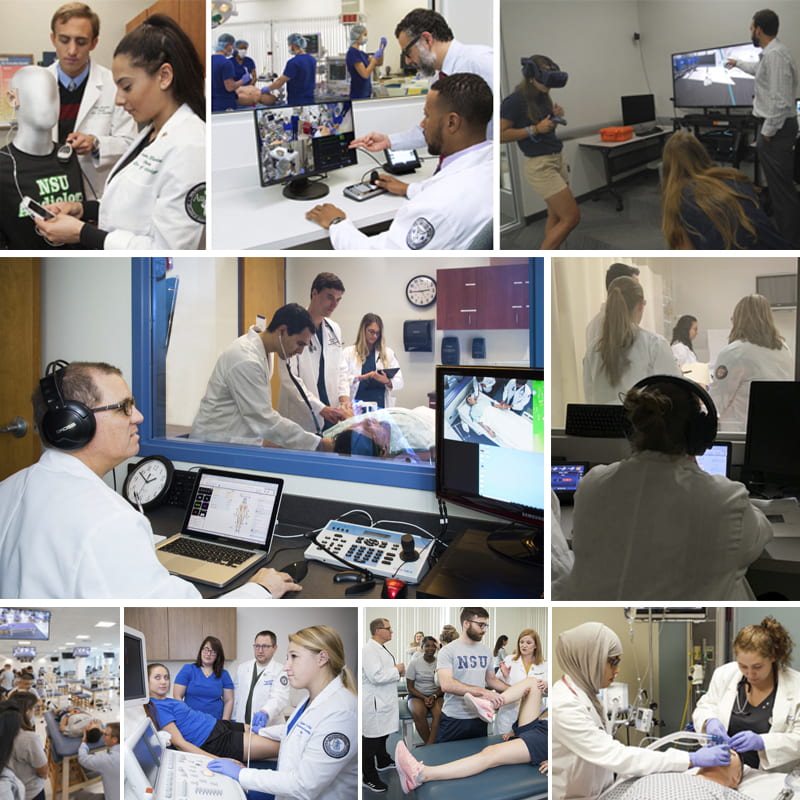How do you provide students experiential learning when “hands-on” training is not an option? NSU’s Dr. Pallavi Patel College of Healthcare Sciences (PCHCS) faced this question when the decision was made in early March to move all classes to an online format. Simulation labs built for students to learn and practice assessment skills (such as taking a blood pressure), procedures like intubation and diagnostic ultrasound to honing their critical thinking and decision making were no longer physically accessible. These labs, with their partial body task trainers and computerized mannequins (simulators) that mimic patients in hospital and provider care environments are only two modalities of simulation represented in the PCHCS currently not able to be utilized by learners, explains Melissa Morris, MSN, RN, CPN, CHSE, director of simulation and interactive technology for PCHCS.
Simulation takes on many forms—immersive virtual and augmented realities, simulated patients (role play with other students, faculty members, or volunteers), computer (2D) simulations, and standardized patients (individuals trained to portray patients in a strict and standardized repeatable way for healthcare education, evaluation and research) who depict healthcare patients so realistically that they cannot be detected from a real patient to name a few. All of these modalities are used so students can experience a replication of a real-life healthcare situation to practice procedural and decision-making skills and reflect on their actions to gain understanding for professional competence and patient safety.
Moving to a completely online platform has meant introducing new simulation technologies into many of the allied health professions curriculum within the PCHCS. Morris has helped the PCHCS multiple programs on 6 campuses identify, assess, and procure products that have not been used at NSU before.
“In the PCHCS, there are nine different disciplines and 30 different programs, each one requiring different simulation solutions to support, and augment clinical and didactic content,” says Morris. “What works for the Physician Assistant program may not work for Physical or Occupational therapy, Speech Language Pathology or Audiology, and I assist programs in identifying solutions that best meet the needs for their learner’s skills and knowledge acquisition. We know there are products out there that can fill some of the gaps created by lack of face to face instruction, and clinical rotation opportunities but cost has been an issue. We’re trying to figure out what companies will work with us moving forward.”
The transition has not been without obstacles—product cost is certainly one, but quality of internet connection, availability of equipment, like gaming-quality computers, virtual reality headsets, and high-definition cameras, are others that students and faculty members face. In an ideal world, Morris would ensure that each discipline had a simulation operations specialist to manage and maintain the technology and equipment necessary for recreating simulation environments, and that all students, faculty members, and the university itself had access to the infrastructure needed for optimizing the platforms utilized for simulation activities.
In her role, Morris is a resource to guide programs within the PCHCS to the simulation tools most tailored to their curriculum, especially as she believes virtual simulation and online learning are here to stay. “We were headed in this direction … to VR and AR platforms and using simulation. There’s been a lot of resistance in the past to simulation, the COVID crisis has accelerated the use of the technology” says Morris. “Now, as a university, and definitely as a college, we have to figure out how we keep these simulation platforms and to use them to the best of their ability.
Moving forward, “There’s going to be times when we’re going to be all together and times when we’re going to have to stay at home, so we have to be able to move between face to face and digital instruction seamlessly.”
In addition to serving as an expert on health care simulation for health profession education, Morris has used her knowledge and experience to collaborate on two programs that enhance NSU’s ability to give students the edge in healthcare education.
Patients in training
This past semester, the College of Arts, Humanities, and Social Sciences (CAHSS) began offering THEA 2500 Healthcare Theater, a course designed to train students to become standardized patients (SP). The curriculum is team-taught by Morris and CAHSS theatre faculty Mark Duncan, M.F.A., and Bill J. Adams, D.M.A. Over the course of the semester, students are exposed to various performance techniques, multiple healthcare professions and introduced to concepts of diversity, cultural humility, empathy and interprofessional practice. Once they have completed the course, these students are eligible to apply for SP assignments for face to face and telehealth encounters increasing the diversity and number of SP’s available for simulation activities within the PCHCS and NSU.
Telehealth
“With COVID-19, telehealth has just exploded,” says Morris. She is the course developer and instructor of the Telepresence course. One of three in the Doctor of Health Science Telehealth concentration. The course focuses on how to implement a successful telehealth encounter. From introducing yourself, to how create an empathetic and engaging space where patients want to return to for seeking care; “how to take your bedside manner and make it your webside manner”.
For more information about how you or your organization can help support PCHCS and our simulation programs, please contact NSU Director of Development Nathalie Sloane, nsloane@nova.edu, or 954-262-7123

